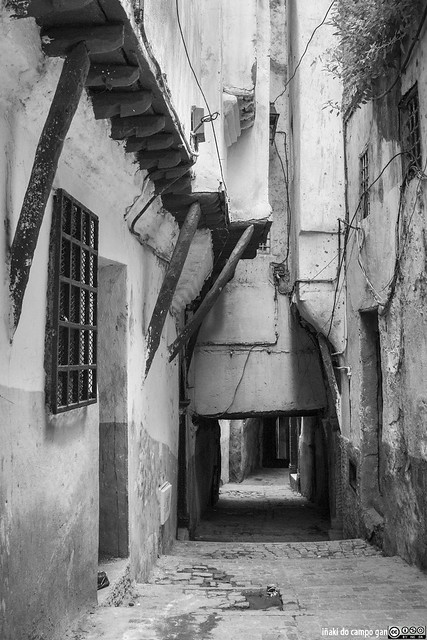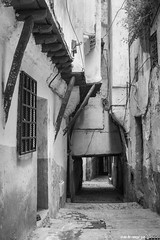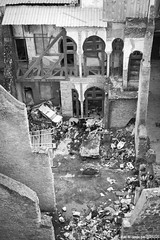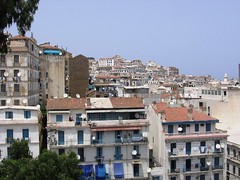Casbah of Algiers
The Casbah (Arabic: [[wikt:قصبة, ''qaṣba'', meaning citadel) is the citadel of Algiers in Algeria and the traditional quarter clustered around it. In 1992, the United Nations Educational, Scientific and Cultural Organization (UNESCO) proclaimed Kasbah of Algiers a World Cultural Heritage site, as "There are the remains of the citadel, old mosques and Ottoman-style palaces as well as the remains of a traditional urban structure associated with a deep-rooted sense of community."
Etymology
More generally, a kasbah is the walled citadel of many North African cities and towns. The name made its way into English from French in the late 19th century (the Oxford English Dictionary states 1895), and can be spelled "kasbah" or "casbah."
History
The Casbah of Algiers is founded on the ruins of old Icosium in the 10th century. It was a city built on a hill, stretching towards the sea, divided into the "High city" and the "Low city". One finds there masonry and mosques dating from the 17th century: Ketchaoua Mosque (built in 1794 by the Dey Baba Hassan) flanked by two minarets; Djama’a al-Djedid (1660, at the time of the Ottomans) with its large finished ovoid cupola points some and its four cupolas; Djamaâ el Kebir (the oldest of the mosques), built by Almoravid ruler Yusuf ibn Tashfin; and Ali Bitchin Mosque (Raïs, 1623). The Casbah also contained several palaces, including Dar Aziza, Dar Mustapha Pacha, Palace of the Dey, and Dar Hassan Pacha which was built in 1791 to house the Pasha, who lived there for eight years.
In 1839, shortly after the French conquest, the French governor moved into Dar Hassan Pacha. In 1860, Napoleon III and Eugénie de Montijo visited. Before French rule, the casbah contained around 13 Jama Masjids, 109 mosques, 32 mausoleums and 12 Zawiyas, total of 166 religious-related buildings. However, the majority of these religious buildings were destroyed during the occupation. In 1862, there were only nine Jama Masjids, 19 mosques, 15 mausoleums and five Zawiyas left. Many mosques such as Ketchauoua Mosque and Berrani Mosque were converted into building with non-Islamic purposes, such as military barracks and churches.
The Casbah played a central role during the Algerian War of Independence (1954–1962). During the early years of the war, the Casbah was the epicenter of the insurgency planning of the National Liberation Front (FLN), from which it planned and executed attacks against French citizens and law enforcement agents in Algeria at the time. In order to counter their efforts, the French authorities launched operations in the Casbah during the Battle of Algiers.
Current condition
The ANSS, the conservation agency of the Algerian government, reported that 373 buildings in the Casbah have collapsed. Of the 1816 buildings that remain, 40% are ruined or in a critical state, and 10% are boarded up.
Reuters reported in August 2008 that the Casbah was in a state of neglect and certain areas were at risk of collapse.
Algerian authorities list age, neglect and overpopulation as the principal contributors to the degeneration. Overpopulation makes the problem especially difficult to solve because of the effort it would take to relocate the residents. Estimates range from 40,000 to 70,000 people, although it is difficult to be certain due to the number of squatters in vacant buildings. One reason that the government wants to improve the condition of the Casbah is that it is a potential hideout for criminals and terrorists. In the late 1950s and during the civil insurrection and struggle against French colonial rule it was the hideout for the National Liberation Army (Algeria).
Preservationist Belkacem Babaci described the situation as difficult, but not insurmountable, saying: “I still believe it’s possible to save it, but you need to empty it and you need to find qualified people who will respect the style, the materials. It’s a huge challenge.” Restoration projects have been plagued by delays and endemic corruption.
In popular culture
- The Casbah of Algiers plays a central role in the 1937 French film Pépé le Moko and the 1938 American film Algiers, in which the noted jewel thief Pepe le Moko, played by Jean Gabin in the French version and Charles Boyer in the American version hide there after a heist in France, and he becomes a local leader, but as time passes, he begins to feel trapped in the district. Although in the American film, Boyer never said to costar Hedy Lamarr "Come with me to ze Casbah," this line was in the Hollywood movie trailer, and it would stick with him, thanks to generations of impressionists and Looney Tunes parodies.
- Boyer's role as Pepe Le Moko was already world-famous when animator Chuck Jones based the character of Pepé Le Pew, the romantic skunk introduced in 1945's Warner Bros. cartoon Odor-able Kitty, on Boyer, his voice – imitated by Mel Blanc – and the catch phrase "Come with me to ze Casbah" from his most well-known performance.
Notable people
- Abd al-Rahman al-Tha'alibi (1384-1479)
- Abdelhalim Bensmaia (1866-1933)
- Mohamed Charef (1908-2011)
- Brahim Boushaki (1912-1997)
- Abderrahmane Taleb (1930-1958)
- Djamila Bouhired (born 1935)
- Djamila Boupacha (born 1938)
- Mustapha Toumi (1937-2013)
External links
- Images of Algiers Casbah in Manar al-Athar digital heritage archive resource
Looking for places related to Casbah of Algiers?
Those are other destinations to find places related to Casbah of Algiers:
- Houari Boumediene A…
- Casbah of Algiers
- Beni Hammad Fort
- Stade 5 Juillet 1962
- Royal Mausoleum of …
- Ketchaoua Mosque
- Bibans
- Cathédrale du Sacré…
- Gouraya
- Great Mosque of Alg…
- Chréa
- Djurdjura
- Islas Alhucemas
- Théniet El Had
- Depression of Grana…
- Formentera
- Castillo de Orihuela
- Tell Atlas
- Colegio Hispania
- Chafarinas Islands
- Espacio Mediterráneo
- Villa Calamari
- Monasterio de San G…
- Cuartel de Antigones




